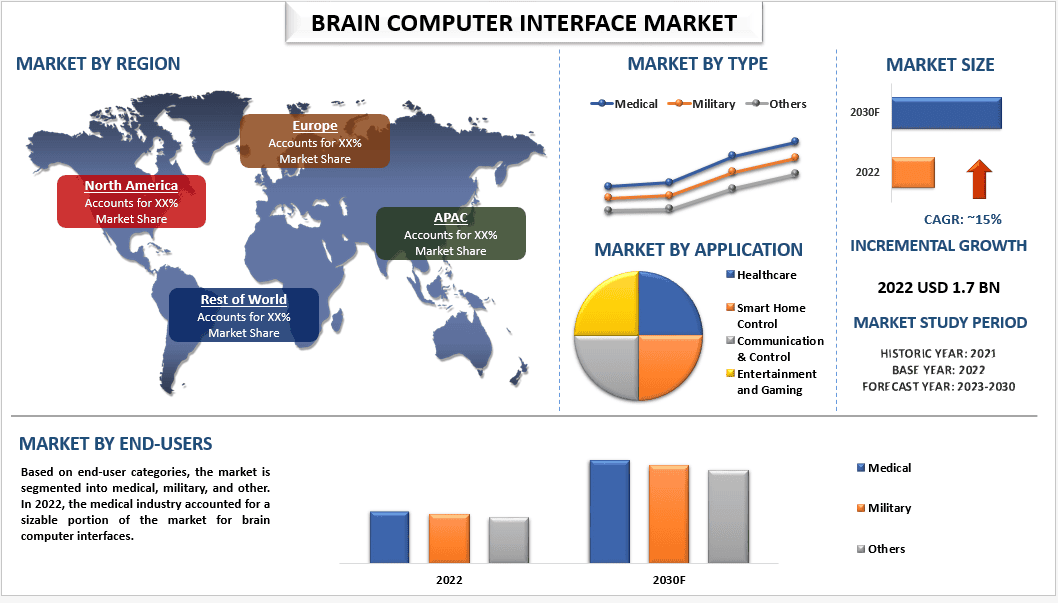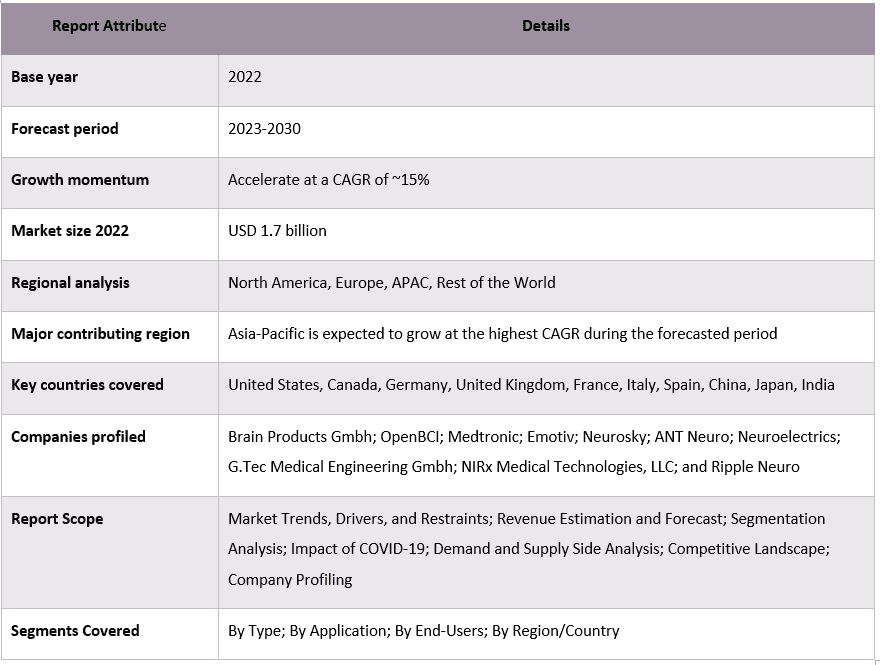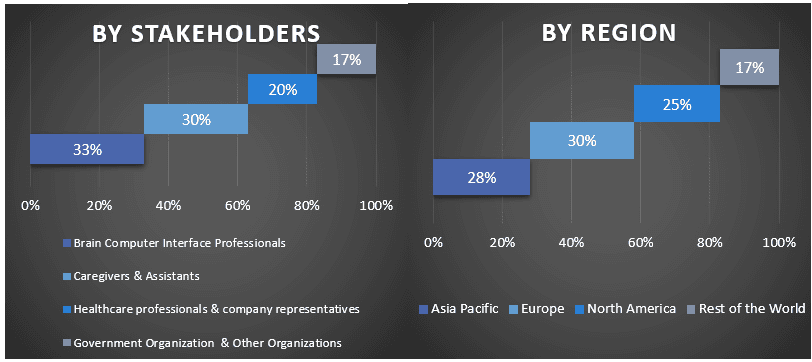- Home
- About Us
- Industry
- Services
- Reading
- Contact Us
Brain Computer Interface Market: Current Analysis and Forecast (2023-2030)
Emphasis on Type (Invasive and Non-invasive); Application (Healthcare, Smart Home Control, Communication & Control, Entertainment and Gaming); and End-Users (Medical, Military and Others); Region/Country.

The Brain Computer Interface (BCI) Market is expected to grow at a strong CAGR of ~15% during the forecast period (2023-2030). Research, assistance, mapping, and augmentation are all common uses for the Brain Computer Interface (BCI) technology, which enables a functional brain to interface directly with peripheral electronic devices that are utilized to allow mobility in impaired persons. The main goal of BCI is to recover the vital functions of patients with neuromuscular illnesses who are incapacitated. Factors such as the increasing prevalence of neurodegenerative disorders, rising R&D activities by the companies to improve the brain-computer interface technology, and various technological advancements such as the miniaturization of devices. Additionally, one of the main factors that may encourage the growth of the market during the projected period is the increase in Research and development activities by several firms and funding from governments in the development of BCI technology. For instance, in August 2020, according to an article titled “Funding for Brain-Computer Interface Ventures” published the Australian Federal Government granted a research consortium called Bionic Vision Australia a USD 42 million grant to develop bionic vision technology, a type of brain-computer interface technology.
Some of the major players operating in the market include Brain Products Gmbh; OpenBCI; Medtronic; Emotiv; Neurosky; ANT Neuro; Neuroelectrics; G.Tec Medical Engineering Gmbh; NIRx Medical Technologies, LLC; and Ripple Neuro.
Insights Presented in the Report
“Amongst type, the non-invasive is expected to have a major market share over the projection period.”
Based on type, the market is segmented into invasive and non-invasive. The non-invasive category is expected to have a major market share over the projection period. Due to its widespread use in gadgets like headphones, gaming sticks, and amplifiers, the market is expanding. It is anticipated that the development of non-invasive brain-computer interface devices based on EEG would make BCI technology more widely available. Invasive BCIs are also utilized to recover the use of limbs by utilizing brain-controlled robotic arms and legs and to restore eyesight by linking the brain with external cameras. For example, the Food and Drug Administration (FDA) of the United States has authorized the use of a brain-computer interface device to help stroke patients with their hands.
“Amongst end-users, medical industry accounted for a sizable portion of the market”
Based on end-user categories, the market is segmented into medical, military, and other. In 2022, the medical industry accounted for a sizable portion of the market for brain computer interfaces since BCI technology helps people with conditions including paralysis, parkinsonism, epilepsy, and Alzheimer’s disease move more freely. Followed by the military sector which is anticipated to develop at the quickest rate because of growing BCI technology utilization during combat operations. The development of robots that can serve as armed drones in conflict zones and cutting-edge communication technologies like the Defense Advanced Research Projects Agency’s (DARPA) “Silent Talk” system, which would allow soldiers and military personnel to give orders through telepathic communication, is expected to support the expansion of this market.
Brain Computer Interface Market Report Coverage

“Asia-Pacific is anticipated to have the market’s highest growth throughout the anticipated timeframe”
Asia-Pacific is anticipated to have the market’s highest growth throughout the anticipated timeframe. Factors such as rising healthcare costs, and patient awareness are anticipated to grow the BCIs in this region. As a result of favorable tax laws and affordable production locations, the Asia-Pacific market is drawing in foreign investors. New technology also includes a wide range of applications intended to transform security, automation, and communication workflows. For instance, in 2021, Tianjin University’s neuro-engineering team was working on the research and development of the second-generation “BrainTalker” chip, which uses less power and offers higher system-on-chip integration, and the researchers reported that they were able to extract “good-quality” brain intentions from electroencephalogram signals that could meet application requirements.
Reasons to buy this report:
- The study includes market sizing and forecasting analysis validated by authenticated key industry experts.
- The report presents a quick review of overall industry performance at one glance.
- The report covers an in-depth analysis of prominent industry peers with a primary focus on key business financials, product portfolios, expansion strategies, and recent developments.
- Detailed examination of drivers, restraints, key trends, and opportunities prevailing in the industry.
- The study comprehensively covers the market across different segments.
- Deep dive regional level analysis of the industry.
Customization Options:
The global brain computer interface market can further be customized as per the requirement or any other market segment. Besides this, UMI understands that you may have your own business needs, hence feel free to connect with us to get a report that completely suits your requirements.
Table of Content
Research Methodology for the Brain Computer Interface Market Analysis (2023-2030)
The three main processes performed to construct and assess the adoption of brain computer interface in significant regions throughout the world were estimating the existing market, analyzing the historical market, and projecting the future market. To gather the historical market data and calculate the current market size, extensive secondary research was done. Second, a variety of conclusions and presumptions were considered in order to validate these discoveries. In-depth primary interviews with industry leaders from all points along the worldwide market for brain computer interfaces were also undertaken. After making an initial assumption and verifying it with primary interviews, we used a top-down/bottom-up methodology to anticipate the total market size. After that, methodologies for data triangulation and market breakdown were used to estimate and analyze. Detailed methodology is explained below:
Analysis of Historical Market Size
Step 1: In-Depth Study of Secondary Sources:
Detail secondary study was conducted to obtain the historical market size of the brain computer interface market through company internal sources such as annual reports & financial statements, performance presentations, press releases, etc., and external sources including journals, news & articles, government publications, competitor publications, sector reports, third-party database, and other credible publications.
Step 2: Market Segmentation:
After obtaining the historical market size of the brain computer interface market, we conducted a detailed secondary analysis to gather historical market insights and share for different segments & sub-segments for major regions. Major segments are included in the report as type, application, and end-users. Further country-level analyses were conducted to evaluate the overall adoption of testing models in that region.
Step 3: Factor Analysis:
After acquiring the historical market size of different segments and sub-segments, we conducted a detailed factor analysis to estimate the current market size of the brain computer interface market. Further, we conducted factor analysis using dependent and independent variables such as type, application, and end-users of the brain computer interface market. A thorough analysis was conducted for demand and supply-side scenarios considering top partnerships, mergers and acquisitions, business expansion, and product launches in the brain computer interface market sector across the globe.
Current Market Size Estimate & Forecast
Current Market Sizing: Based on actionable insights from the above 3 steps, we arrived at the current market size, key players in the global brain computer interface market, and market shares of the segments. All the required percentage shares split, and market breakdowns were determined using the above-mentioned secondary approach and were verified through primary interviews.
Estimation & Forecasting: For market estimation and forecast, weights were assigned to different factors including drivers & trends, restraints, and opportunities available for the stakeholders. After analyzing these factors, relevant forecasting techniques i.e., the top-down/bottom-up approach were applied to arrive at the market forecast for 2030 for different segments and sub-segments across the major markets globally. The research methodology adopted to estimate the market size encompasses:
- The industry’s market size, in terms of revenue (USD) and the adoption rate of the brain computer interface market across the major markets domestically
- All percentage shares, splits, and breakdowns of market segments and sub-segments
- Key players in the global brain computer interface market in terms of products offered. Also, the growth strategies adopted by these players to compete in the fast-growing market
Market Size and Share Validation
Primary Research: In-depth interviews were conducted with the Key Opinion Leaders (KOLs) including Top Level Executives (CXO/VPs, Sales Head, Marketing Head, Operational Head, Regional Head, Country Head, etc.) across major regions. Primary research findings were then summarized, and statistical analysis was performed to prove the stated hypothesis. Inputs from primary research were consolidated with secondary findings, hence turning information into actionable insights.
Split of Primary Participants in Different Regions

Market Engineering
The data triangulation technique was employed to complete the overall market estimation and to arrive at precise statistical numbers for each segment and sub-segment of the global brain computer interface market. The data was split into several segments & sub-segments post studying various parameters and trends in the areas of the product, technology, and end-users in the global brain computer interface market.
The main objective of the Global Brain Computer Interface Market Study
The current & future market trends of the global brain computer interface market were pinpointed in the study. Investors can gain strategic insights to base their discretion for investments on the qualitative and quantitative analysis performed in the study. Current and future market trends determined the overall attractiveness of the market at a regional level, providing a platform for the industrial participant to exploit the untapped market to benefit from a first-mover advantage. Other quantitative goals of the studies include:
- Analyze the current and forecast market size of the brain computer interface market in terms of value (USD). Also, analyze the current and forecast market size of different segments and sub-segments
- Segments in the study include areas of the type, application, and end-users
- Define and analysis of the regulatory framework for the brain computer interface industry
- Analyze the value chain involved with the presence of various intermediaries, along with analyzing customer and competitor behaviors of the industry
- Analyze the current and forecast market size of the brain computer interface market for the major region
- Major countries of regions studied in the report include Asia Pacific, Europe, North America, and the Rest of the World
- Company profiles of the brain computer interface market and the growth strategies adopted by the market players to sustain in the fast-growing market
- Deep dive regional level analysis of the industry
Related Reports
Customers who bought this item also bought










